Carlos Garcia was taken from Okeechobee, Fla., by his mother when he was 13 months old. Carlos' father was determined to bring his son home and contacted local law enforcement and the National Center for Missing & Exploited Children (NCMEC), a private, nonprofit organization that works with law enforcement and child-advocacy agencies to create a unified, coordinated response to cases of missing and exploited children.
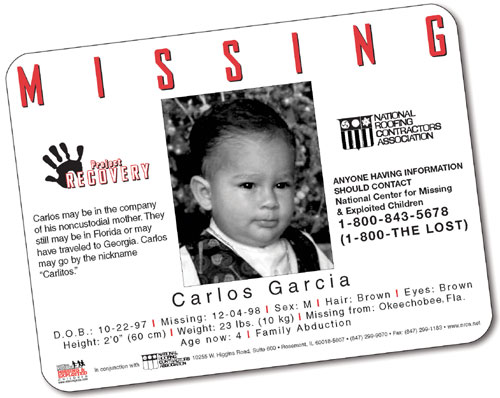
NCMEC applied all its resources to Carlos' case, including using its many databases, the media and FBI. NCMEC also called on more than 360 corporate and organizational partners that rely on their businesses and members to find missing children in various ways.
Carlos' photograph and biographical information appeared on a poster that was displayed by Division 7 Roofing & Sheet Metal Inc., Holly Hill, Fla. When Carlos was located on June 28, 2002, he became the second child Division 7 Roofing & Sheet Metal helped locate through Project Recovery, NRCA's partnership with NCMEC.
What NCMEC does
NCMEC was co-founded by John Walsh, host of the television show "America's Most Wanted" and nationally recognized advocate for victims' rights and missing children. Walsh and his wife, Revé, began developing NCMEC when they realized there was no national resource to help parents of missing children. Unfortunately, the catalyst for NCMEC was the abduction and murder of the Walshes' 6-year-old son, Adam, in 1981.
Soon after NCMEC's creation in 1984, the organization realized it could not confront the plight of missing children without help. NCMEC, therefore, initiated several methods to get businesses and individuals involved in the search for missing children. These methods include poster programs similar to Project Recovery; NCMEC's Picture Them Home campaign, which raises awareness about the importance of distributing photographs to find missing children; and Project ALERT, which recruits retired and volunteer law-enforcement officers to help local police departments work on difficult missing-child cases.
No matter what NCMEC method is used, a case first must be organized by an NCMEC case manager.
Charles Pickett, an NCMEC senior case manager, worked on Carlos' case and about 1,100 others during 2002. Pickett has been employed by NCMEC since its creation and describes his role as "a guy who looks for missing kids."
Although Pickett doesn't glorify his job, he is revered by the many families he has reunited. Pickett absorbs himself in each case and estimates he has helped recover more than 15,000 missing children.
"Recovering a missing child is like Christmas for me," Pickett explains.
When a missing child is registered with NCMEC, the child's biographical and contact information and photograph are posted on the organization's Web site, www.missingkids.org. The information and photograph also are prepared for radio and television broadcasts, as well as publication in magazines, newspapers, newsletters and other resources.
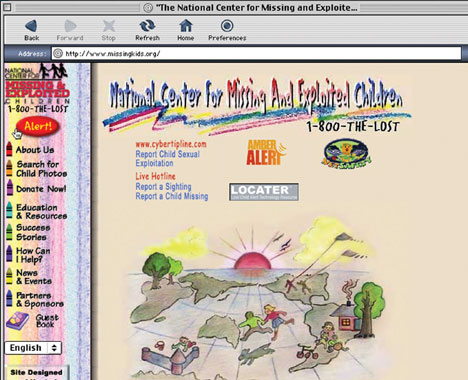
The National Center for Missing & Exploited Children's Web site, www.missingkids.org, is a convenient resource that allows individuals to become involved in the search for missing children.
"The media and public are what bring in the leads to solve a case," Pickett says. "We have to work together."
In addition, the information is presented for use by NCMEC's corporate and organizational partners' programs. This is how Carlos' information became available to NRCA for use in Project Recovery.
Project Recovery
In August 2001, NRCA became aware of a poster partnership between the Mechanical Service Contractors of America (MSCA) and NCMEC. MSCA was distributing posters of missing children to its members to be placed on their service vehicles. Knowing NRCA could implement a similar program to find missing children in its members' areas, NRCA staff contacted NCMEC to learn how the association could become involved.
Bill Good, NRCA's executive vice president, played a key role in forming NRCA's partnership with NCMEC.
Good says: "NRCA members are involved in their communities daily, serving their customers. Using our members' vehicles to deliver messages about missing and exploited children is just a natural fit—and NCMEC has embraced our involvement."
After an overwhelmingly positive response from NRCA members who received a preliminary mailing to gauge their interest in a poster partnership with NCMEC, NRCA established Project Recovery in November 2001. Since then, the association's members have helped locate 21 children. The recovered children hail from Florida, Illinois, Indiana, Michigan, Minnesota, Pennsylvania and Texas. But the program is not confined to these states, and NRCA always is seeking sponsors in all U.S. areas.
NRCA offers three categories of annual Project Recovery sponsorship. Primary sponsors donate $1,000 and receive 10 posters. Supporting sponsors donate $500 and receive five posters, and sustaining sponsors donate $100 and receive three posters. NRCA also accepts monetary donations of any amount to support Project Recovery, as well as payment for the cost of magnetic posters, which is $30 per poster. NRCA does not keep any donated money for its own use; all donations are applied toward Project Recovery posters and publicity. In addition, all sponsors and donors are recognized on NRCA's Web page dedicated to Project Recovery, www.nrca.net/rp/about/charity/prorec/default.aspx.
Project Recovery requires coordination among NRCA staff members who provide information and posters to contractors and receive updates from NCMEC about missing children. Once a child is listed as missing from a contractor's area, the contractor is sent 18- by 24-inch or 18- by 12-inch (457- by 610-mm or 457- by 305-mm) magnetic posters for his service vehicles. The number of posters sent depends on a contractor's request. Posters include a child's photograph taken around the time he or she was reported missing, as well as biographical and contact information.
Once a child has been located, NCMEC alerts NRCA via e-mail and NRCA sends a "FOUND" sticker to the contractor. Stickers are to be placed over posters to alert a contractor's community about Project Recovery's success. The contractor then can order replacement posters or continue displaying posters of a located child with a "FOUND" sticker.
Sullivan Roofing Inc., Mount Prospect, Ill., became a Project Recovery primary sponsor soon after NRCA established the program. Although it is nearly impossible to determine all the tools that help locate a missing child, six children whose posters were displayed on Sullivan Roofing's service vehicles have been located and are safe. Tim Sullivan, the company's president, had personal reasons for getting his company involved with Project Recovery.
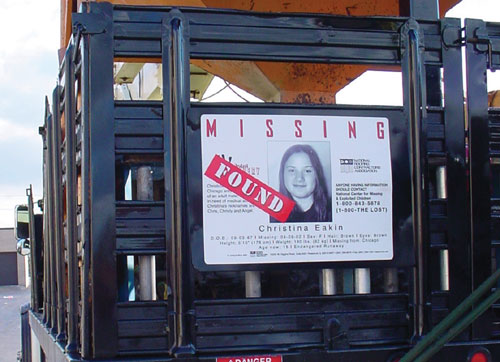
Six children whose posters were displayed on Mount Prospect, Ill.-based Sullivan Roofing Inc.'s service vehicles have been located and are safe.
Sullivan explains: "Being a parent, I cannot imagine the terror that comes from your child being abducted. And if I can help bring a child home to his or her family because someone saw one of the many posters on our vehicles, it is a joyous occasion for me, as well."
Never forget a face
According to NCMEC, media coverage helps raise public awareness about the importance of finding missing children,especially during the critical first three hours after a child's abduction. And initiatives, such as Project Recovery, that spread information about missing children greatly help with recoveries. NCMEC reports that one of six missing children is found when someone recognizes his or her photograph and notifies authorities.
Project Recovery also helps demonstrate positive contributions to communities made by the roofing industry, which helps improve its image.
Without its members, NRCA cannot continue to help NCMEC locate missing children. For more information about Project Recovery or to become a sponsor, call me at (800) 323-9545, Ext. 231; fax (847) 299-1183; or e-mail ckoch@nrca.net.
Placing posters on your service vehicles is an easy way to help your community and affect people's lives. It's already affected the families of the 21 children Project Recovery has helped find.
Christina Koch is associate editor of Professional Roofing magazine and NRCA's manager of public relations.
The lost
After working with law enforcement on more than 85,000 missing child cases and locating more than 68,000 children, the National Center for Missing & Exploited Children (NCMEC) is recognized as the national clearinghouse for information about and recovery of missing children. Although precise statistics about missing children are difficult to obtain because of different definitions for "missing" within various law-enforcement jurisdictions, some figures are available to gauge the plight.
Recent media coverage has made the number of missing children seem astronomical, but according to the FBI's National Crime Investigation Center, the number of missing juveniles has declined 5 percent since 2000.
However, about 725,000 children were reported missing during 2001. About 45 percent were listed as runaways; 43 percent were listed as benign explanations, such as a miscommunication between a child and caretaker about a curfew or meeting place; lost, injured or otherwise missing children accounted for 8 percent; 7 percent were listed as family abductions; and nonfamily abductions accounted for 2 percent.
Although the number of children reported missing has decreased, we should not be complacent. Study the following pictures of missing children. If you have any information to share, call NCMEC at (800) THE-LOST (843-5678). You may have the necessary information to bring home a missing child safe and sound.
JULIAN HERNANDEZ
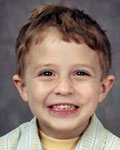 D.O.B.: 03-31-97
D.O.B.: 03-31-97
Missing: 08-28-02
Hair: Light brown
Eyes: Brown
Height: 3 feet (91 cm)
Weight: 43 pounds (19 kg)
Missing from: Birmingham, Ala.
Age now: 5
Julian may be in the company of his noncustodial father. They may be traveling to the Key West, Fla., or Tampa, Fla., areas in a white 1996 Chevrolet Silverado pickup truck with Alabama license plates, 1B4649C. Julian has a freckle on his left cheek near his mouth.
LOGAN TUCKER
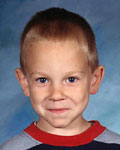 D.O.B.: 04-10-96
D.O.B.: 04-10-96
Missing: 06-23-02
Hair: Blond
Eyes: Blue
Height: 3 1/2 feet (107 cm)
Weight: 42 pounds (19 kg)
Missing from: Woodward, Okla.
Age now: 6
Logan was last seen at home and is missing under suspicious circumstances.
KYNANDE BENNETT
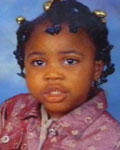
D.O.B.: 08-24-98
Missing: 09-29-02
Hair: Brown
Eyes: Brown
Height: 3 5/6 feet (117 cm)
Weight: 90 pounds (41 kg)
Missing from: Whiteville, N.C.
Age now: 4
Kynande was last seen in the company of her mother at a Kmart store. Kynande has pierced ears and a birthmark on her right arm. She had braids in her hair and was wearing a gray "FUBU" shirt and blue jeans.
ELIZABETH JIMENEZ
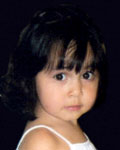
D.O.B.: 06-09-99
Missing: 06-12-02
Hair: Brown
Eyes: Brown
Height: 3 1/4 feet (99 cm)
Weight: 35 pounds (16 kg)
Missing from: Rifle, Colo.
Age now: 3
Elizabeth may be in the company of her noncustodial father. They may have traveled to Mexico. Elizabeth has birthmarks on the right side of her torso and on the back of her right leg. Her nickname is "Eli."
MIRIAM IVETHE SALAS
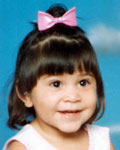
D.O.B.:09-17-99
Missing: 02-01-02
Hair: Black
Eyes: Brown
Height: 3 feet (91 cm)
Weight: 28 pounds (13 kg)
Missing from: Montclair, Calif.
Age now: 3
Miriam may be in the company of her father, Cesar Augusto Salas. They may have traveled to Los Angeles or Mexico. Miriam has pierced ears, and her nickname is "Pooky."
